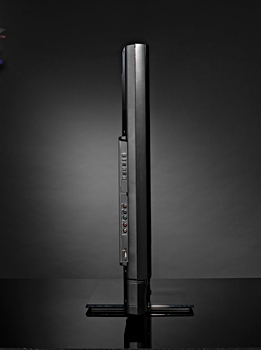Mitsubishi Unisen LT-46153 Page 2
VIDEO PERFORMANCE
| With video and audio adjustments out of the way (mine were done in the set's Advanced Picture and Manual sound projector modes), I was ready to watch TV. Criterion's new Blu-ray Disc edition of director Jacques Tati's Playtime had just arrived, so I tossed that in the disc player. During the film's opening section, where Monsieur Hulot wanders confusedly in a Paris business district, the various gray shades of the modern buildings and the clothing worn by people passing through them were well represented on the Mitsubishi's screen. Skin tones of the office workers came across as natural, and the occasional flourish of bright color - red rose bunches sold by a street vendor, for example - looked rich without coming across as too vivid. Playtime's next section takes place at night outside an apartment building where the residents oddly lack curtains or blinds covering their floor-to-ceiling windows. The Mitsubishi looked punchy on most of these shots, showing good contrast and shadow detail. |
A USB port on the Unisen LT-46153's side panel lets you connect fl ash media to view JPEG photo slideshows or listen to MP3 music. The TV's onscreen media player menu helps you navigate content stored on USB drives. |
|---|
But a few images in this sequence also revealed the set's limited shadow depth - when faced with displaying really dark shots, the set delivered a flat picture. Its performance here was on par with most other LCD TVs I've tested that use a CCFL backlight, however.
Mitsubishi's Smooth 120Hz feature helped to eliminate judder effects from film-based programs. (Unfortunately, there's no equivalent blur-reduction mode for video-based ones like high-def sports.) But it also imparted a "video look" to images at any setting beyond 1 or 2, so I switched it off. The set's deinterlacing and upconversion processing delivered solid, crisp-looking pictures with both standard and high-def sources. And its noise reduction proved capable of cleaning up less than perfect images without softening details. Screen uniformity was mostly good: Pictures retained their contrast and color accuracy over a better than 90° viewing arc, and full-field white test patterns showed no sign of tinting or uneven brightness. A degree of screen "clouding" could be seen on both full-field black test patterns and very dark movie images, however.
AUDIO PERFORMANCE
| With the TV's sound projector set to Surround mode, the Unisen delivered a wide image and an impressive sense of envelopment in the scene from Starship Troopers where the ship starts to careen downward after being attacked by alien projectiles. Surround-channel effects emanated from the sides of the room and, in some cases, seemed to come from behind my head! Watching movies with the Polk subwoofer plugged both in and out, I quickly determined that a sub is essential for this system; without it, the TV's audio becomes edgy at higher volumes, and there's little in the way of bass. Music in 5.1 also sounded really good in Surround mode on the setup: When I caught a live clip of U2 performing "City of Blinding Lights" on MTV's highdef Palladia channel, the Edge's guitar was dense and room-filling, and Bono's vocals came across as full and natural. Dynamics in my 22 x 16 home theater were ultimately limited, but I'm sure you'd get better performance in a smaller space. |  |
|---|
- Log in or register to post comments





















































